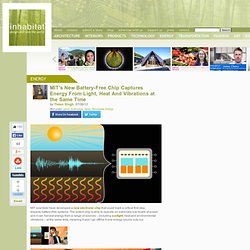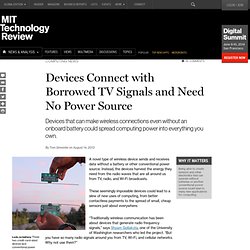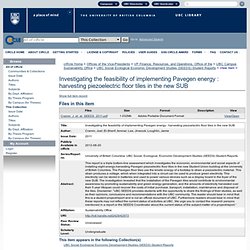

Cityzen smart shirt tracks your health, recharges during washing. Cityzen Science's smart shirt integrates a sensor web, distributed intelligence, communications, and a smartphone app (Photo: Cityzen Sciences) Rightly or wrongly, the French are known for clothing designs that are often less than practical.

Now, however, French company Cityzen Sciences has won the CES 2014 Inclusive Innovation in Everyday Health award for its development of a Smart Sensing fabric woven with integral micro-sensors – these add the practical benefit of monitoring the health and fatigue levels of the wearer. Cityzen smart shirt tracks your health, recharges during washing. Cityzen smart shirt tracks your health, recharges during washing. MIT's New Battery-Free Chip Captures Energy From Light, Heat And Vibrations at the Same Time. MIT scientists have developed a new electronic chip that could mark a critical first step towards battery-free systems.

The potent chip is able to operate on extremely low levels of power, and it can harvest energy from a range of sources – including sunlight, heat and environmental vibrations – at the same time, meaning it won’t go offline if one energy source cuts out. The team developing the new chip is led by MIT professor Anantha Chandrakasan. He describes the new energy-combining chip in the IEEE Journal of Solid-State Circuits, stating that the team’s goal is to create a chip that achieves efficient use of multiple power sources in a single device. By doing so, it would not be reliant on any one source. “Energy harvesting is becoming a reality,” says Chandrakasan, the Keithley Professor of Electrical Engineering and head of MIT’s Department of Electrical Engineering and Computer Science.
“We extract power from all the sources,” says doctoral student Saurav Bandyopadhyays. MIT's New Battery-Free Chip Captures Energy From Light, Heat And Vibrations at the Same Time. MIT's Tiny Kinetic Generator Produces 100 Times More Power from Small Vibrations. The labs at MIT are shaking things up – literally – as they just unveiled a tiny device that harvests energy from everyday, low-frequency vibrations.

The breakthrough gizmo generates 100 times more power than other devices like it, and it can harvest electricity from a wide range of sources including footsteps, auto traffic, and even swaying bridges. Aimed primarily at supporting wireless sensor networks, the device could be used to create an ambient energy harvesting system right under our feet. Scientists have been using wireless sensor networks to measure and monitor the environmental conditions of just about everything these days. They can track pollution, measure bridge and building movement, monitor oil pipelines, and even help predict the temperature changes in forests before a mass fire. Though technological improvements have decreased the energy use of wireless sensor networks, their batteries still need to be changed periodically.
Paper Generators bring a spark of new life to the printed page. A Paper Generator is used to reveal an e-ink greeting Image Gallery (7 images)

Devices Connect with Borrowed TV Signals, and Need No Power Source. A novel type of wireless device sends and receives data without a battery or other conventional power source.

Instead, the devices harvest the energy they need from the radio waves that are all around us from TV, radio, and Wi-Fi broadcasts. These seemingly impossible devices could lead to a slew of new uses of computing, from better contactless payments to the spread of small, cheap sensors just about everywhere. “Traditionally wireless communication has been about devices that generate radio frequency signals,” says Shyam Gollakota, one of the University of Washington researchers who led the project.
“But you have so many radio signals around you from TV, Wi-Fi, and cellular networks. Why not use them?” Gollakota and colleagues have created several prototypes to test the idea of using ambient radio waves to communicate. Here is a video of the prototypes: The devices communicate by varying how much they reflect—a quality known as backscatter—and absorb TV signals. Investigating the feasibility of implementing Pavegen energy : harvesting piezoelectric floor tiles in the new SUB. Show full item record Files in this item This item appears in the following Collection(s) UBC Social Ecological Economic Development Studies (SEEDS) Student Reports All items in cIRcle are protected by copyright, with all rights reserved.

Statistics. Power from the people. 17 October 2011Last updated at 03:41 By David Cohen Technology Reporter The biofuel cell, uses glucose and oxygen at concentrations found in the body to generate electricity.

Plugging gadgets into a socket in the wall, or loading them with batteries - or maybe even unfurling a solar panel - is how most of us think of getting electricity. But what about plugging them into your body? It may sound far fetched, but under the shadow of the Alps, Dr Serge Cosnier and his team at the Joseph Fourier University of Grenoble have built a device to do just that.
Their gadget, called a biofuel cell, uses glucose and oxygen at concentrations found in the body to generate electricity. They are the first group in the world to demonstrate their device working while implanted in a living animal. Biofuel cells could kick-start a revolution in artificial organs and prosthetics that would transform tens of thousands of lives every year. They usually need their power packs replaced 5 years after implantation. Power Felt generates electricity from body heat. Wake Forest University researcher Corey Hewitt, with a sample of the Power Felt Some day, your jacket may be able to power your iPod ... and no, I'm not talking about piezoelectric fabrics (which generate electricity from movement-caused pressure), nor am I talking about photovoltaic materials, although both of those could probably do the job.
